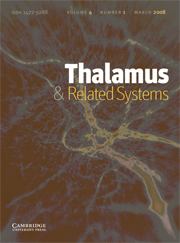Article contents
Anesthetic effects on the thalamus, reticular formation and related systems
Published online by Cambridge University Press: 11 October 2005
Abstract
Anesthetics are used extensively clinically and in research. However, the mechanisms by which anesthetics act to produce the desired end-points of unconsciousness, amnesia and immobility are only beginning to be understood. Recent evidence indicates that the immobilizing effect of anesthetics occurs largely in the spinal cord, whereas it is assumed that the sedative and amnesic actions occur in the brain. Our recent studies, however, indicate that anesthetics exert an indirect, spinal effect on reticulo-thalamo-cortical mechanisms of arousal and, thus, might affect consciousness and memory. These data are consistent with reports of reduced anesthetic requirements for sedation during neuroaxial blockade by spinal anesthesia. The presumed mechanism is decreased afferent impulses to the brain, which reduces arousal and, thereby, reduces sedative requirements. We have used the complementary approaches of single-unit recording and intracranial electrical stimulation to investigate the effects of a common inhaled anesthetic, isoflurane, on reticulo-thalamo-cortical arousal in a goat preparation. The excitatory responses of single neurons in the midbrain reticular formation (MRF) to noxious somatic stimulation are significantly attenuated when the concentration of systemically delivered isoflurane was increased above 1 MAC (the minimum alveolar concentration required to prevent coordinated movement in response to a noxious stimulus), in parallel with a loss of stimulus-evoked desynchronization of the cortical electroencephalogram (EEG). Part of this depressant effect is mediated indirectly in the spinal cord because selectively reducing the concentration of isoflurane delivered differentially to the spinal cord enhances MRF neuronal responses and cortical arousal. In goats anesthetized with isoflurane at ∼1 MAC, electrical stimulation at distinct sites, including the MRF, peduncolopontine tegmentum (PTT), and medial/intralaminar thalamus, elicits desynchronization of the cortical EEG. Increasing the concentration of isoflurane above 1 MAC abolished this effect. In goats prepared for differential delivery of anesthetic to the cranial and torso (spinal) circulations, electrical stimulation in the medial thalamus elicits greater cortical desynchronization at lower currents when the concentration of isoflurane delivered to the spinal cord is reduced while maintaining the cranial isoflurane concentration ≥1 MAC. These results indicate that the depressant effect of isoflurane anesthesia on spinal somatosensory transmission indirectly influences the threshold for reticulo-thalamo-cortical arousal.
Information
- Type
- Research Article
- Information
- Copyright
- © 2005 Cambridge University Press
- 9
- Cited by

